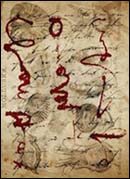
 The History of Text Technologies is a concentration within the Ph.D. program of the English Department. Graduate students seeking a doctoral degree with a concentration in History of Text Technologies should apply for admission to the English Department.
The History of Text Technologies is a concentration within the Ph.D. program of the English Department. Graduate students seeking a doctoral degree with a concentration in History of Text Technologies should apply for admission to the English Department.
Course Requirements
In addition to the general requirements for a Ph.D. in English, the HoTT concentration requires a total of 18 credit hours of courses specific to HoTT, including the following:
1. History of Text Technologies seminar. An historical and theoretical overview of transnational text technologies from prehistory to the present. Students must take this course within two semesters of declaring their concentration. This course is the only one required of all HoTT students.
2. One course in each of three conceptual areas within the history of text technologies:
a) textual production
b) textual transformation
c) textual reception
A variety of courses would qualify. For example, “Production” could be satisfied by a course in medieval manuscripts (Johnson), or early modern print culture (Taylor) or early modern writing for the theatre (Bourus), or cut-ups, playbacks, pick-ups, and mimeographs in the work of William Burroughs (Gontarski), or Television and Music case studies (Edwards, Faulk), or audio studies (Pascoe). “Transformation” could be satisfied by a course on translation across languages and media (Maurette), or one on Editing Shakespeare (Taylor), or one on modern media adaptations of Shakespeare (Bourus), or one on the way digitalization transforms texts and images created by earlier technologies (Graban). “Reception” could be satisfied by a course on early female readers of Romantic poetry (Eckert), or modernist textual interventions (Gontarski), or cross-cultural reception (Maurette) or cross-media reception (Bourus, Fleckenstein, Parker).
3. Students are required to take one or more courses in at least two textual media.
The focus on “technologies” (plural) means that students in this concentration cannot focus all their coursework on a single technology. For the purposes of this requirement, textual media are defined as (a) manuscript (b) print (c) visual texts (d) computing/digital (e) film and television (f) voice recording (g) other. (This final category might include inscription, tattoo or other forms of writing-on-the-body, etc.)
4. The focus on “history” includes the present and future, but it means that students are required to take one or more courses in at least two historical periods.
For example, a student concentrating in the hand-press print period might satisfy this requirement by taking a course in film production or in digital multimedia theory. For the purposes of this concentration, periods are defined as “script” (pre-1476 in English). “hand-press” (1476-1799), “industrial” (1800-1899), and “post-1900”. A course that counts as belonging to the “hand-press” period, for purposes of the chronological distribution, might count as “manuscript” for the media distribution (example: a course focusing on seventeenth-century poetic miscellanies).
5. Recommended: fieldwork in archives (including the FSU-affiliated Newberry Library in Chicago, with FSU financial support), a relevant course in another FSU department (such as Stephanie Leitch’s Art History course on Renaissance prints, or Sonia Hazzard’s History course on religion and print in early America), study and research abroad, at least one semester in the Digital Scholars reading group.
6. In order to satisfy any of these requirements, or to count toward the required 18 credit areas for the concentration, a course must be approved by the Director of HoTT (currently Gary Taylor).
7. “Double-dipping.” We encourage the intelligent selection of rich and multi-faceted courses so as to fulfill these requirements easily. Although all students must take the four courses specified above in paragraphs 1 and 2, the distribution requirements in paragraphs 3 and 5 could be satisfied by courses in paragraph 2. A course that satisfies a HoTT concentration requirement might also satisfy an English department distribution requirement, although the department’s own chronological boundaries and requirements (e.g., pre-1660, 1660–1900, alterity) are not identical to those of HoTT.

For more information on the HoTT program, please contact:
English Professor Gary Taylor gtaylor@fsu.edu

